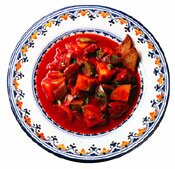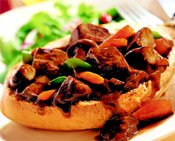|
Stew Gets New
The name may be inelegant, but this hearty icon can be stylish and sophisticated.
By Allison Austin, Special to R&I
For many diners, stews call to mind chilly nights and kitchen-table meals that offset cold edges. In restaurants, though, they can be a hard sell.
“The first thing we need to do is come up with a new name for them,” says Jeff Drew, executive chef of Snake River Grill in Jackson, Wyo. “Whenever I come up with an idea for a stew and tell my cooks about it, they all just look at me. Then one will say, ‘But what are we going to call it?’”
Drew and his cooks know that the homey connotations that make stew an appealing Sunday-night-at-home option can work against them in a restaurant.
 |
| A fall favorite, goulash (above) can be made with less-expensive beef cuts such as shank, although veal also is a delicious stew star. |
|
Much of the difficulty can be traced to stews that are quite often forgettable. As diners become more knowledgeable about food and techniques, dishes that appear as an afterthought, a way to clean out the pantry or utilize leftover meats and vegetables, are less appealing than dishes that have special-occasion, can’t-make-it-at-home flair.
But chefs find fresh, creative ways to improve stew’s stodgy image. By capitalizing on the popularity of locally grown, seasonal ingredients as well as the increased interest in unique, exotic meats, they’re adding excitement to this food-cost-friendly one-dish meal.
The Game Game
According to a U.S. Department of Agriculture study released in May, 35% of higher-end restaurants regularly purchase exotic meats, including buffalo, venison and kangaroo. And while beef and chicken still rule on most of these menus, many chefs find that the increased popularity of exotic meats is an easy way to add allure to slow-cooked menu dishes such as braises and stews.
Drew knows this firsthand. Diners visiting Jackson, Wyo., where buffalo have been known to walk down the street, come to Snake River Grill with wild game meat on their minds. He capitalizes on these cravings by creating stew recipes with exotic meats, such as the buffalo and white-bean stew with smoked tomatoes on his fall menu. Large cubes of buffalo prime rib are grilled off and then added, along with smoked tomatoes, to the warm broth at the end of the cooking process. This extra step ensures that the meat remains tender and medium-rare, and also allows flavors to mingle while still retaining their distinct tastes and textures.
 |
 |
| A bread bowl adds interest to beef stew (top). Pork, hominy and cilantro can combine (above) for a Southwestern rendition. |
|
Not only is this dish seasonal and full-flavored without being heavy, it’s also cost-effective. Drew finds that diners are more willing to pay higher prices for stews that include exotic meats. “When you put stew on the menu for $23.95, diners can’t get past it.” But he adds, “Using game means we can charge higher prices, especially here in Jackson.”
Johnathan Sundstrom has found similar results at Lark, his restaurant on Seattle’s Capitol Hill. His rustic, Northern European cooking is just what chilly, soggy Seattle craves. Lark’s venison stew was such a hit last winter that he’s planning to bring it back again once temperatures drop this year. To prepare the stew, Sundstrom uses the “Denver leg,” a partially boned-out cut with the silver skin removed. He simmers celery, carrots, onion and seasonal wild mushrooms, and serves the stew in a heavy cast-iron pot with fresh parsley and a slice of crispy bacon draped over the top.
Seasons Change
Another excellent way to add zest and appeal to a stew recipe is with fresh locally sourced ingredients and, just as important, to change the menu often to reflect that freshness to the customer. At Corte Madera, Calif.-based Il Fornaio restaurants, chefs design daily specials that not only appeal to the growing number of consumers interested in locally grown ingredients, but also utilize any seasonal produce overages they might have in the walk-ins.
In addition to these daily specials, the chain runs an ongoing promotion celebrating local dishes of the many regions of Italy. Brusciuvia, a mixed-bean soup that springs to life with fresh garden vegetables, is on the menu in early September; in mid-October, Vellutata Romagnola, a heartier mushroom soup from the Emilia-Romagna region made with caramelized mushrooms, potatoes and Parmesan cheese, will satisfy those first cool-weather cravings.
But how can an operator in a perennially warm climate include stew on the menu? At his San Francisco restaurant Quince, Chef Michael Tusk makes the most of the area’s temperate climate, long local growing season and wealth of local, organic produce by changing his menu daily. This allows him to alter dishes based on weather forecasts.
When fog rolls in over the Golden Gate Bridge, local diners look for substantive dishes. Tusk caters to these cravings with a sort of half-stew, half-braise, usually utilizing a less-expensive cut of meat such as lamb shoulder. Because the restaurant brings in whole animals and breaks them down in house, Tusk reduces food costs by using bones for stocks, the tougher cuts for slow-braising and high-end cuts, such as the lamb ribs and loins, for more-expensive entrées.
 |
| Piedmont Pork Stew — combining pork loin, carrots, raisins and mushrooms — makes a hearty fall entrée. |
|
He has found that using interesting grains, such as farro, increases the allure of his soups and stews. This fall he’ll feature duck legs braised with quince, onion, carrot, celery root and red wine. He’ll partner it with locally grown chicory or a farro timbale.
Plan for Leftovers
At the Mountain View, Calif., headquarters of Google Inc., Charlie Ayers (one-time chef for legendary rock band The Grateful Dead) feeds between 2,500 and 4,000 hungry techies each day, and smart menu planning is a must. Still, with so many interesting meal stations specializing in dishes from around the world as well as traditional American favorites, leftovers are unavoidable. Chef Ayers uses this surplus not only to create daily specials but as a basis for standard menu items such as his Texas Sirloin Chili, made from leftover sirloin (from steak sandwiches) and skirt steak (from carne asada).
Another clever use of surplus product is spicy Angry Pork Stew, which utilizes pork from the Southwestern and Asian stations. Ayers braises the pork with cinnamon, cumin, chiles, molasses and ginger and then thickens it with roasted pumpkin. Just before service, he adds fresh corn, cilantro and mint and serves the stew with gingered mashed yams and braised greens.

Stirring the Pot
Stews often are not just specialties of the house but of the region as well, especially when they use local ingredients. Some examples:
|

